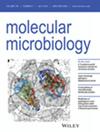Pseudomonas syringae Socially Induced Swimming Motility Requires the Molybdenum Cofactor
IF 2.6
2区 生物学
Q3 BIOCHEMISTRY & MOLECULAR BIOLOGY
引用次数: 0
Abstract
Social interactions among bacteria can induce behaviors that affect their fitness and influence how complex communities assemble. Here we report a new socially induced motility behavior that we refer to as baited expansion in丁香假单胞菌社会性诱导的游泳运动需要钼辅助因子
细菌之间的社会互动可以诱导影响其适应性的行为,并影响复杂群落的聚集方式。在这里,我们报告了一种新的社会诱导的运动行为,我们称之为诱饵扩张在丁香假单胞菌pv。番茄DC3000 (Pst DC3000),一种植物致病菌。我们发现Pst DC3000对附近的Dickeya dianthicola或Escherichia coli菌落表现出强烈的诱导游泳运动。我们开发了一个控制系统来可视化和表征诱饵膨胀的发展。我们的研究结果提供了证据,表明诱饵膨胀行为是对诱饵群体建立和维持的化学梯度的响应。我们还发现这种行为与不同的转录谱相关,并确定了钼辅助因子(Moco)和Moco -利用氧化还原酶作为促进诱饵扩张行为的关键因素。
本文章由计算机程序翻译,如有差异,请以英文原文为准。
求助全文
约1分钟内获得全文
求助全文
来源期刊

Molecular Microbiology
生物-生化与分子生物学
CiteScore
7.20
自引率
5.60%
发文量
132
审稿时长
1.7 months
期刊介绍:
Molecular Microbiology, the leading primary journal in the microbial sciences, publishes molecular studies of Bacteria, Archaea, eukaryotic microorganisms, and their viruses.
Research papers should lead to a deeper understanding of the molecular principles underlying basic physiological processes or mechanisms. Appropriate topics include gene expression and regulation, pathogenicity and virulence, physiology and metabolism, synthesis of macromolecules (proteins, nucleic acids, lipids, polysaccharides, etc), cell biology and subcellular organization, membrane biogenesis and function, traffic and transport, cell-cell communication and signalling pathways, evolution and gene transfer. Articles focused on host responses (cellular or immunological) to pathogens or on microbial ecology should be directed to our sister journals Cellular Microbiology and Environmental Microbiology, respectively.
 求助内容:
求助内容: 应助结果提醒方式:
应助结果提醒方式:


